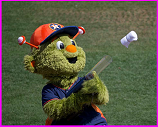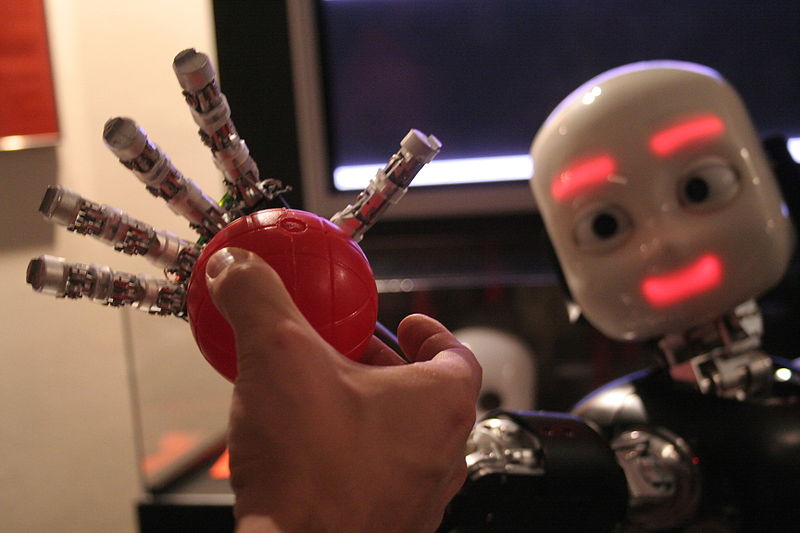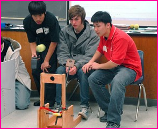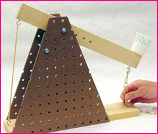Posted on October 21st, 2019 by ASEE
 This simple catapult activity for students in grades 4 – 8 teaches them how energy is transferred when a plastic spoon is pulled back, then released, rocketing its payload — a single marshmallow.
This simple catapult activity for students in grades 4 – 8 teaches them how energy is transferred when a plastic spoon is pulled back, then released, rocketing its payload — a single marshmallow.
Read More
Filed under: Class Activities, Grades 6-8, Grades K-5, Grades K-5, Lesson Plans | Comments Off on Activity: Catapult Marshmallow Launch
Tags: catapult, Class Activities, Energy, forces and motion, Fun & Games, Grades 4 - 8, Grades K-5, Newton's Laws, NGSS, Physical Science, Physics, trebuchet
Posted on October 4th, 2017 by Mary Lord
 Students follow the engineering design process to design and build a usable device to propel school T-shirts up into the stands during home sporting events while keeping costs under budget.
Students follow the engineering design process to design and build a usable device to propel school T-shirts up into the stands during home sporting events while keeping costs under budget.
Read More
Filed under: Class Activities, Grades 6-8, Grades 6-8, Grades 9-12, Grades 9-12, Grades 9-12, Lesson Plans | Comments Off on Flying T-Shirt Challenge
Tags: catapult, cheerleaders, Class Activities, Engineering Design Process, forces, Grades 6-8, Grades 9-12, Lesson Plan, maker challenges, motion, Physics, Sports, T-shirt cannon, teachengineering, tools
Posted on March 18th, 2013 by Mary Lord
 In this activity, students in grades 5 to 12 learn about accuracy, precision, and simple machines by working in teams to design and build a robotic basketball “player” that can nail a free-throw shot three times in a row.
In this activity, students in grades 5 to 12 learn about accuracy, precision, and simple machines by working in teams to design and build a robotic basketball “player” that can nail a free-throw shot three times in a row.
Read More
Filed under: Class Activities, Grades 6-8, Grades 6-8, Grades 6-8, Grades 9-12, Grades 9-12, Grades 9-12, Lesson Plans | 2 Comments »
Tags: accuracy, basketball, biomechanical engineering, biomechanics, catapult, Class Activities, Engineering, lever, Mathematics, percentages, Physics, precision, projectile, Robotics, simple machines, Sports Engineering, statistics
Posted on October 16th, 2012 by Mary Lord
 Students in grades 1 to 6 follow the engineering design process to build and test a catapult that launches projectiles, such as marshmallow “pumpkins.” They then make changes to improve their launcher’s aim and distance it can hurl the projectile.
Students in grades 1 to 6 follow the engineering design process to build and test a catapult that launches projectiles, such as marshmallow “pumpkins.” They then make changes to improve their launcher’s aim and distance it can hurl the projectile.
Read More
Filed under: Class Activities, Grades 6-8, Grades K-5, Lesson Plans | Comments Off on Target Practice: Pumpkin Launcher
Tags: catapult, Design, Elementary Education, Engineering Design, forces and motion, Halloween, levers, motions and forces, Physics, simple machines
Posted on August 28th, 2011 by Mary Lord
 You don’t have to be an engineer to introduce engineering concepts and design into your classroom. The eGFI site includes scores of inexpensive, engaging lessons – searchable by grade level or subject – that cover the various engineering disciplines. To kick off the school year and acquaint you with eGFI, we’ve assembled a dozen of 2011’s most popular lessons and activities. Have fun putting some “E” in your STEM classes this semester!
You don’t have to be an engineer to introduce engineering concepts and design into your classroom. The eGFI site includes scores of inexpensive, engaging lessons – searchable by grade level or subject – that cover the various engineering disciplines. To kick off the school year and acquaint you with eGFI, we’ve assembled a dozen of 2011’s most popular lessons and activities. Have fun putting some “E” in your STEM classes this semester!
Read More
Filed under: Class Activities, Grades 6-8, Grades 6-8, Grades 9-12, Grades 9-12, Grades K-5, Lesson Plans, Special Features | Comments Off on Hands-on Hits of 2011
Tags: Aerospace, balloon racers, bridge, build, catapult, Civil Engineering, Class Activities, earthquake, Grades 6-8, Grades 9-12, Grades K-5, Lesson Plan, Lesson Plans, Nanotechnology, Structural Engineering, Teacher Resources, tower
Posted on November 21st, 2010 by ASEE
 In this lesson, students in grades 4-12 learn about the history of catapults and how they work. They assemble their own catapult model, making adjustments to improve its performance. Students gain engineering experience while learning principles of physics and working with the scientific processes of experimentation and trial and error.
In this lesson, students in grades 4-12 learn about the history of catapults and how they work. They assemble their own catapult model, making adjustments to improve its performance. Students gain engineering experience while learning principles of physics and working with the scientific processes of experimentation and trial and error.
Read More
Filed under: Class Activities, Grades 6-8, Grades 6-8, Grades 9-12, Grades K-5, Grades K-5, Lesson Plans | Comments Off on Lesson: Build a Catapult
Tags: catapult, Class Activities, Engineering in History, forces and motion, Grades 5-12, Grades 6-8, Lesson Plan, Mathematics, Newton's Laws, Physical Science
 This simple catapult activity for students in grades 4 – 8 teaches them how energy is transferred when a plastic spoon is pulled back, then released, rocketing its payload — a single marshmallow.
This simple catapult activity for students in grades 4 – 8 teaches them how energy is transferred when a plastic spoon is pulled back, then released, rocketing its payload — a single marshmallow.








 Students follow the engineering design process to design and build a usable device to propel school T-shirts up into the stands during home sporting events while keeping costs under budget.
Students follow the engineering design process to design and build a usable device to propel school T-shirts up into the stands during home sporting events while keeping costs under budget.  Students in grades 1 to 6 follow the engineering design process to build and test a catapult that launches projectiles, such as marshmallow “pumpkins.” They then make changes to improve their launcher’s aim and distance it can hurl the projectile.
Students in grades 1 to 6 follow the engineering design process to build and test a catapult that launches projectiles, such as marshmallow “pumpkins.” They then make changes to improve their launcher’s aim and distance it can hurl the projectile. You don’t have to be an engineer to introduce engineering concepts and design into your classroom. The eGFI site includes scores of inexpensive, engaging lessons – searchable by grade level or subject – that cover the various engineering disciplines. To kick off the school year and acquaint you with eGFI, we’ve assembled a dozen of 2011’s most popular lessons and activities. Have fun putting some “E” in your STEM classes this semester!
You don’t have to be an engineer to introduce engineering concepts and design into your classroom. The eGFI site includes scores of inexpensive, engaging lessons – searchable by grade level or subject – that cover the various engineering disciplines. To kick off the school year and acquaint you with eGFI, we’ve assembled a dozen of 2011’s most popular lessons and activities. Have fun putting some “E” in your STEM classes this semester! In this lesson, students in grades 4-12 learn about the history of catapults and how they work. They assemble their own catapult model, making adjustments to improve its performance. Students gain engineering experience while learning principles of physics and working with the scientific processes of experimentation and trial and error.
In this lesson, students in grades 4-12 learn about the history of catapults and how they work. They assemble their own catapult model, making adjustments to improve its performance. Students gain engineering experience while learning principles of physics and working with the scientific processes of experimentation and trial and error.